This post may contain affiliate links. For more information, please see our affiliate policy.
For the best, most delicious homemade Chicken Broth recipe, start with a whole raw chicken or chicken pieces and simple vegetables and herbs. At the end of it, you’ll have 4 cups of delicious cooked chicken and 2 quarts of the best chicken broth you’ve ever tasted. Freeze it for your future soups, stews, and casseroles.
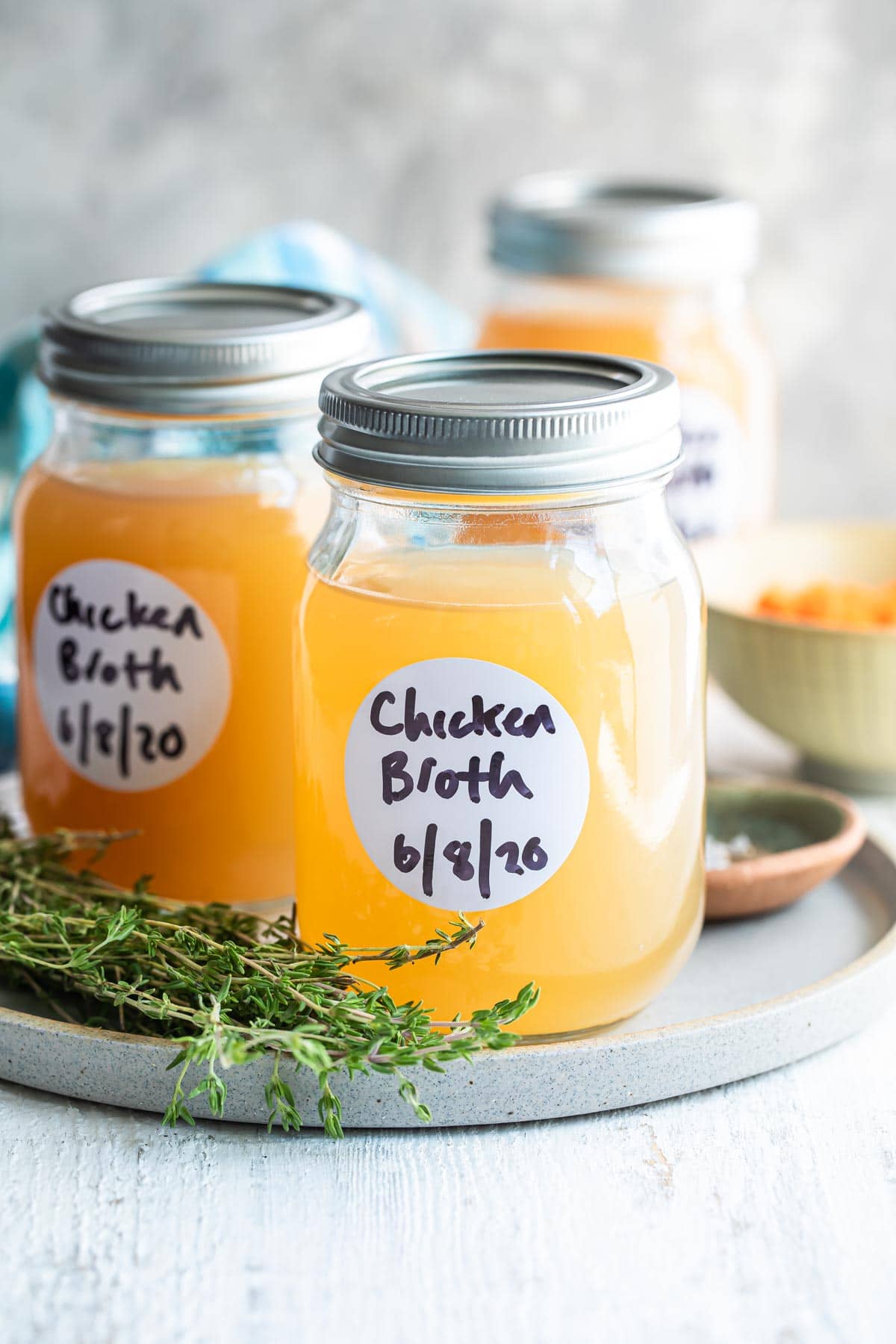
One of life’s simple pleasures is poaching a whole chicken. Here we do it to make homemade broth, but you can also do it to make chicken – and either way, you get both!
In my opinion, this is a fun, relaxing Sunday ritual that more people should try. We are always so busy on the weekends, and poaching a chicken forces you to press pause. It’s fulfilling to create with your hands, so enjoy the moments you chop your veggies and pull spices off their sprigs. You are creating something.
At the end, you’ll have big batch of broth that’s perfect for soups, sauces, and even gravy. And of course, you’ll have the chicken. It’s perfect in Chicken Tinga, Chicken Salad, or in a chicken soup recipe. Whether it’s Chicken Noodle Soup with chunks of tender chicken or creamy Chicken Soup with Wild Rice, nothing beats this cozy bowl of homemade comfort.
Table of Contents
Recipe ingredients
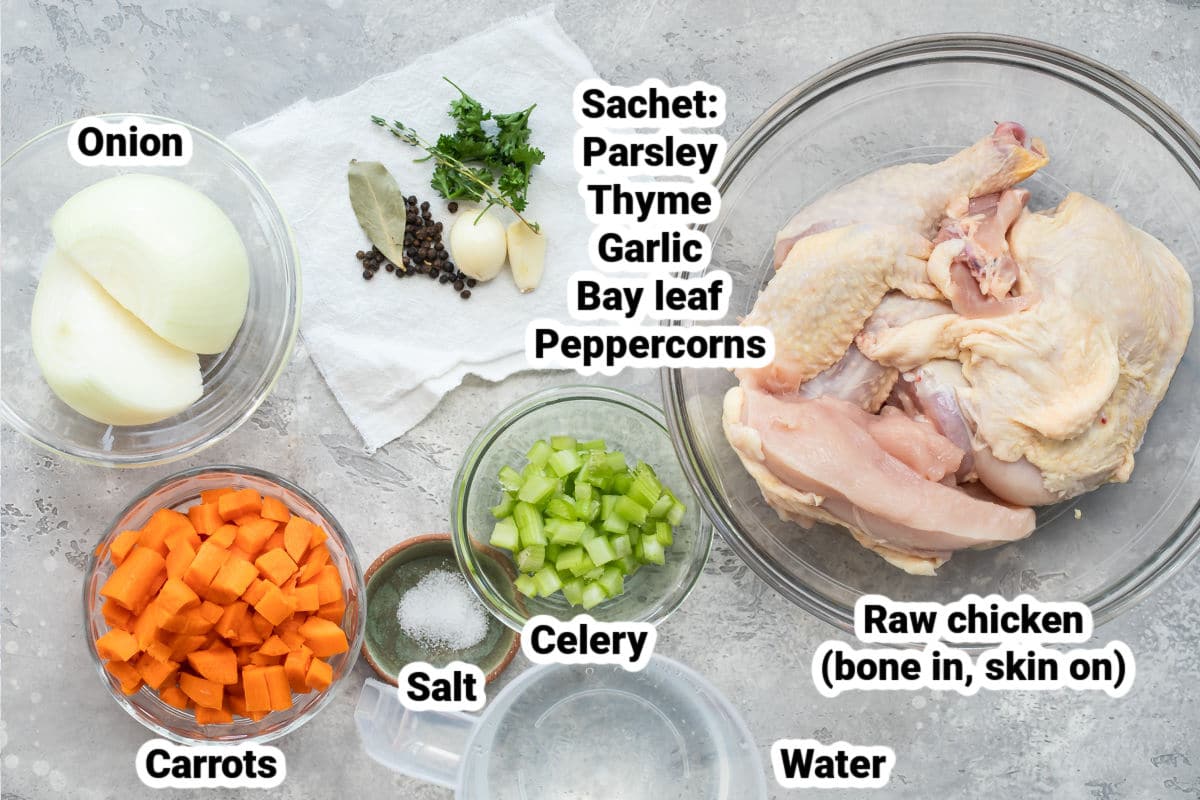
At a Glance: Here is a quick snapshot of what ingredients are in this recipe.
Please see the recipe card below for specific quantities.
Ingredient notes
- Chicken: This recipe uses a whole raw chicken or the equivalent of cut-up pieces (you can do 4 to 5 pounds of bone-in, skin-on chicken breast, thighs, drumsticks, necks, wings, whatever!).
- Organ meats: The heart and gizzard can be added to the broth if desired, but the liver should be discarded or reserved for another purpose.
- Cold water: Always start with cold water. This helps keep the broth clear, not cloudy. The amount of water used and the length of simmering time will determine the intensity of the broth.
- Vegetables: Some cooks save old vegetable trimmings to add to their broth. I prefer to start with new, fresh vegetables because I think the broth will taste better. So yes, we peel the carrots, and save your vegetable scraps for composting!
- Herbs and spices: A sachet is a fancy term for parsley stems, thyme, bay leaves, peppercorns, and optionally, garlic or cloves, tied up in a piece of cheesecloth with twine. You could also use a tea ball or loose-leaf tea bag to hold them. It makes it easier to pull these small ingredients out of the broth later. Or, you can just add everything straight to the pot since you strain the broth at the end.
Step-by-step instructions
- To a Dutch oven or large stock pot, add chicken and cold water to cover (see note 3). Over medium-high heat, bring to a boil. Immediately reduce heat to low and skim the foam off the top of the liquid with a spoon.
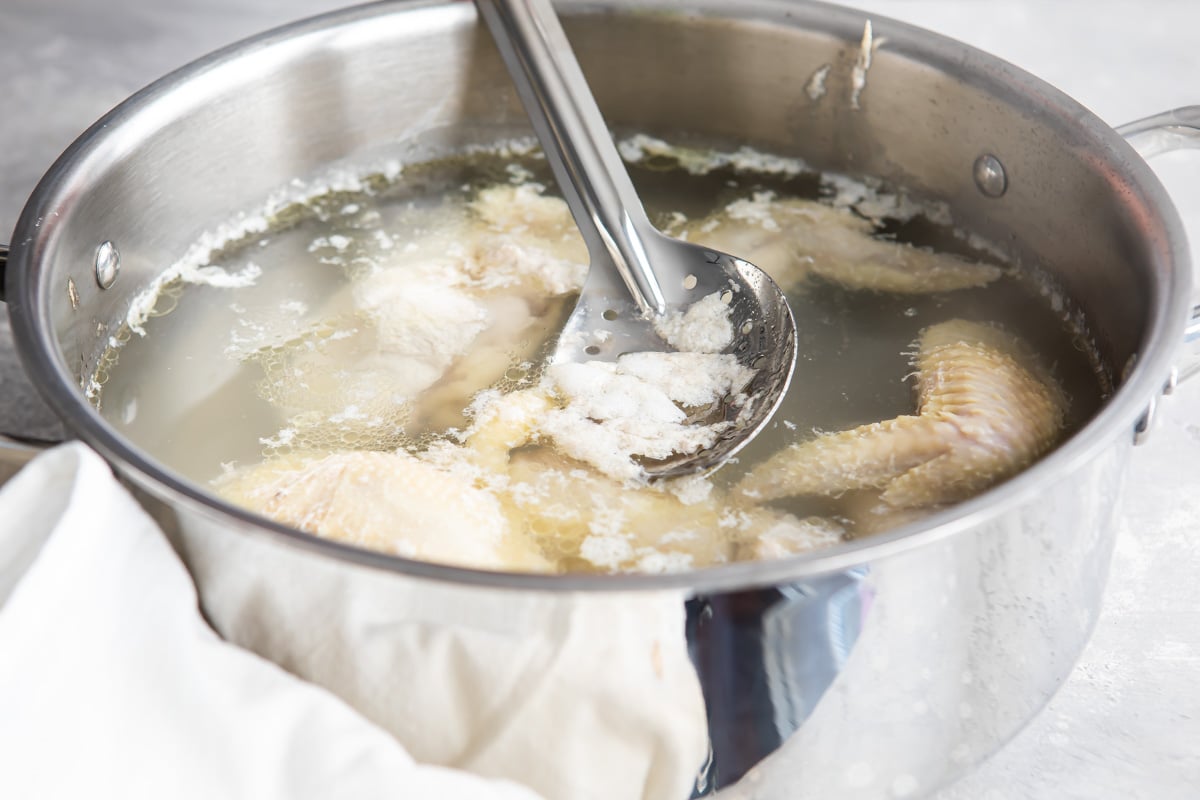
- To the pot add onion, carrot, celery, and salt. If desired, tie parsley stems, thyme, garlic, bay leaf, and peppercorns to make a sachet or add loosely to the pot.
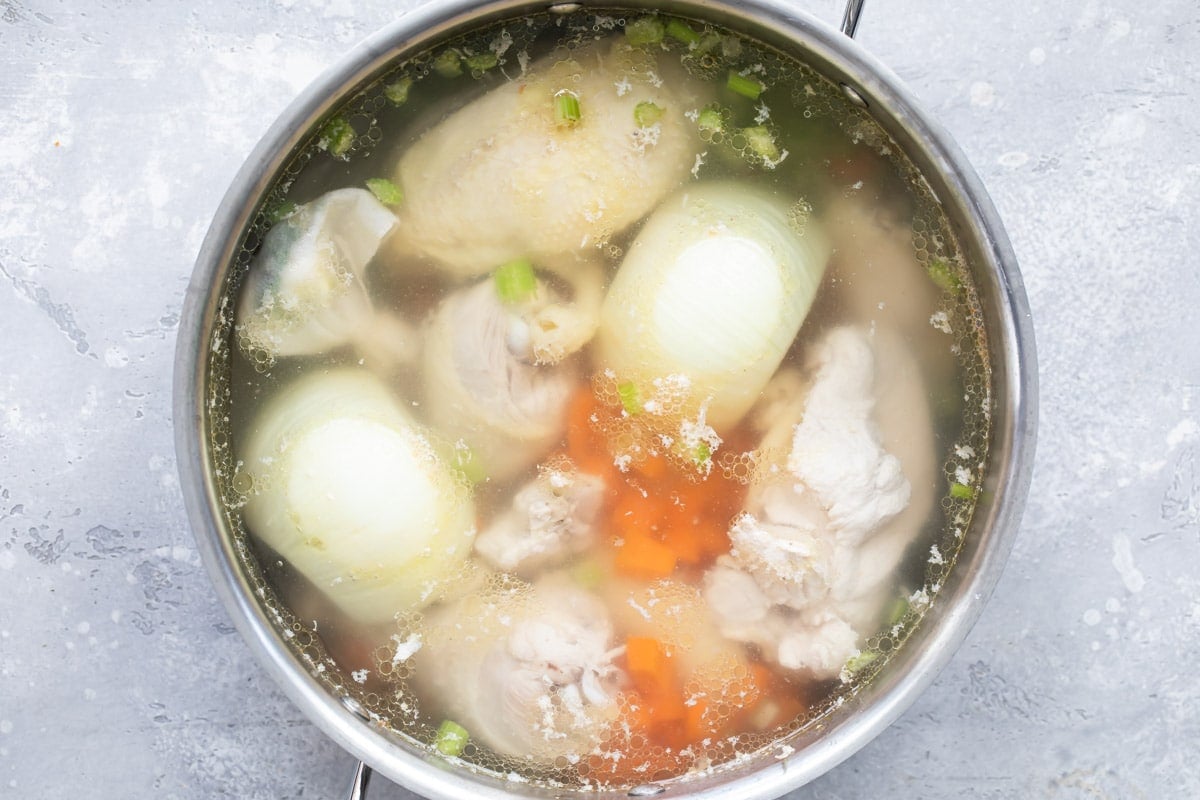
- Simmer gently (bubbles should barely break the surface at irregular intervals) until the chicken is cooked through, at least 1 hour or up to 5 hours. The longer the broth simmers, the more flavor it will have. (NOTE: After 1 hour, you should remove the chicken breasts from the pot to prevent them from drying out).
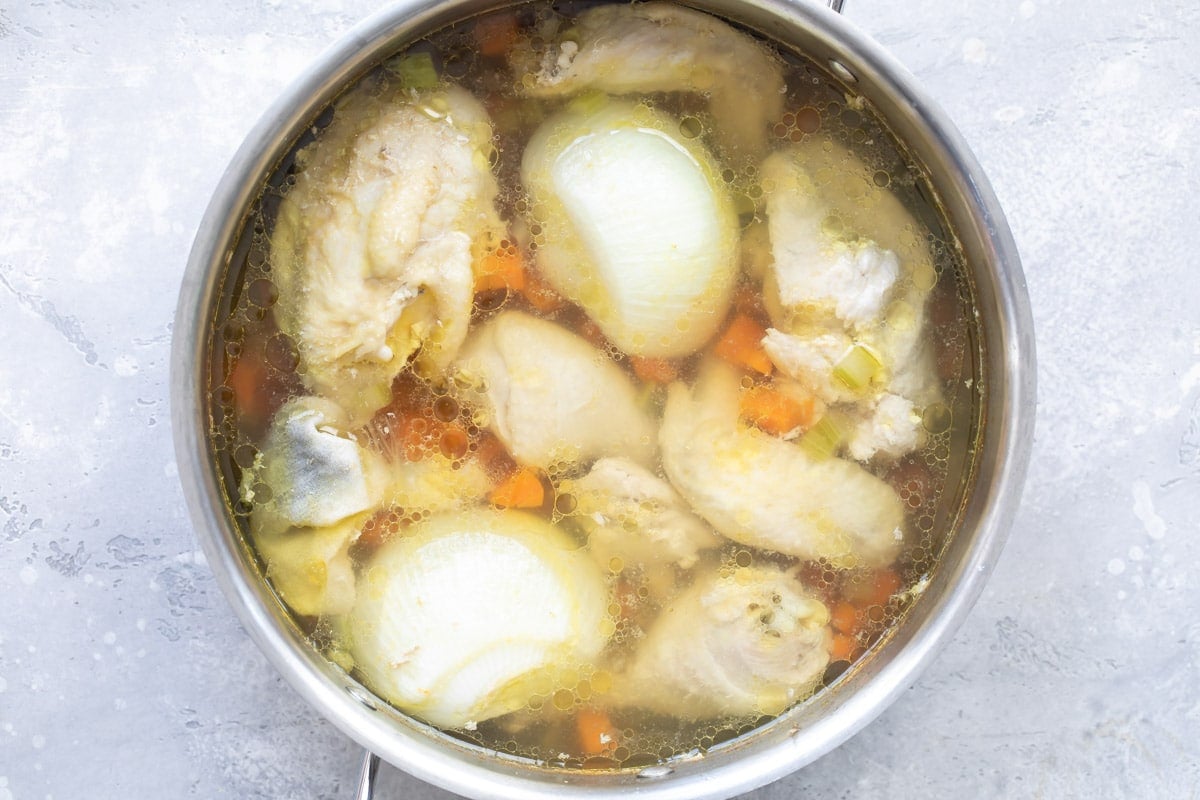
- Remove chicken from pan to a rimmed baking sheet or large bowl. Separate chicken, discarding skin and bones (you should have about 4 cups chicken).
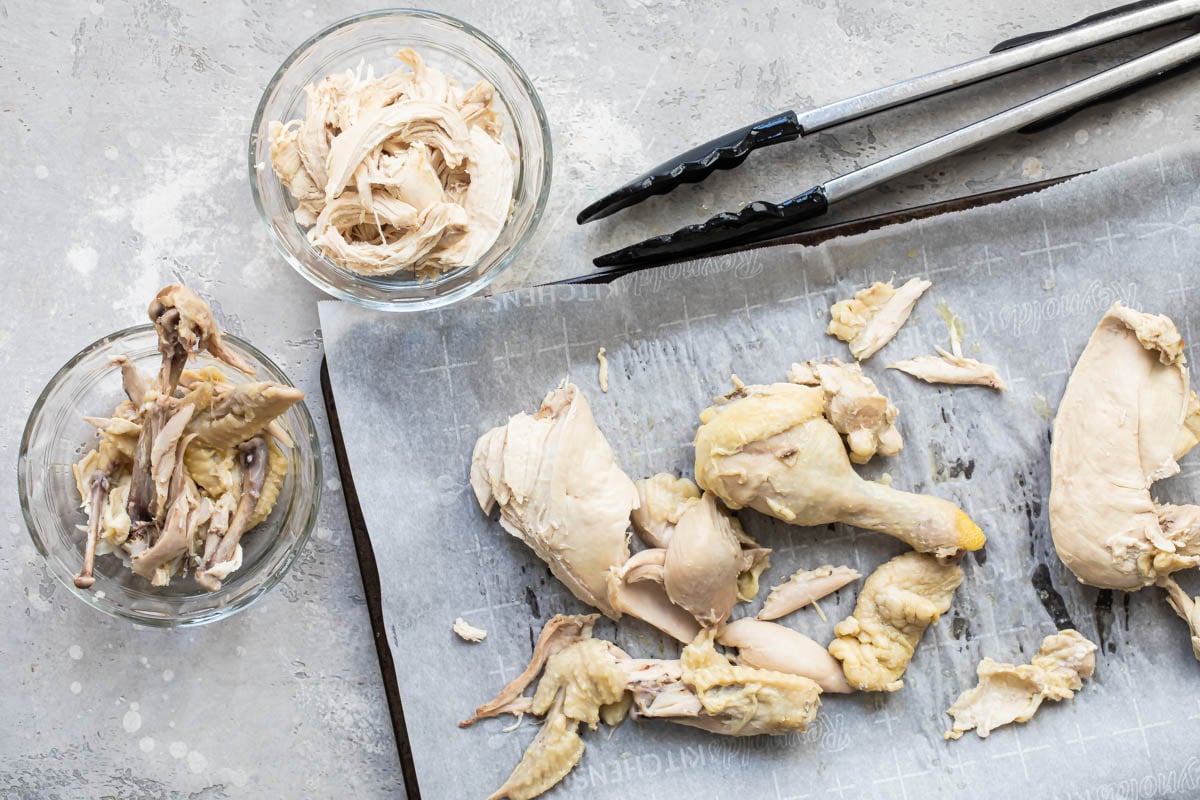
- Strain the broth through a fine-mesh sieve or cheesecloth. Place in a large bowl and chill covered overnight in the refrigerator.
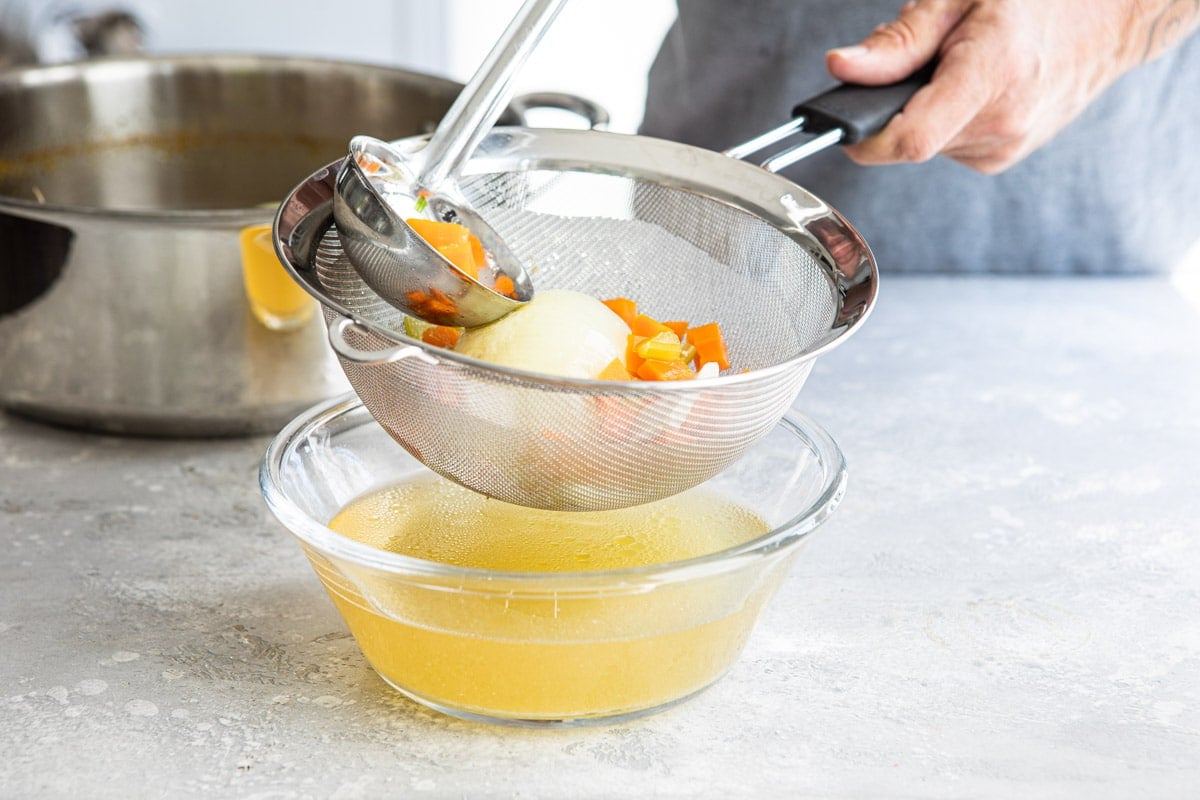
- The next day, scrape off the accumulated fat from the top of the stock and discard. Divide the broth into freezer-safe containers (leaving at least 1/2-inch for expansion), label, and freeze. Or, refrigerate and use within 4 days.
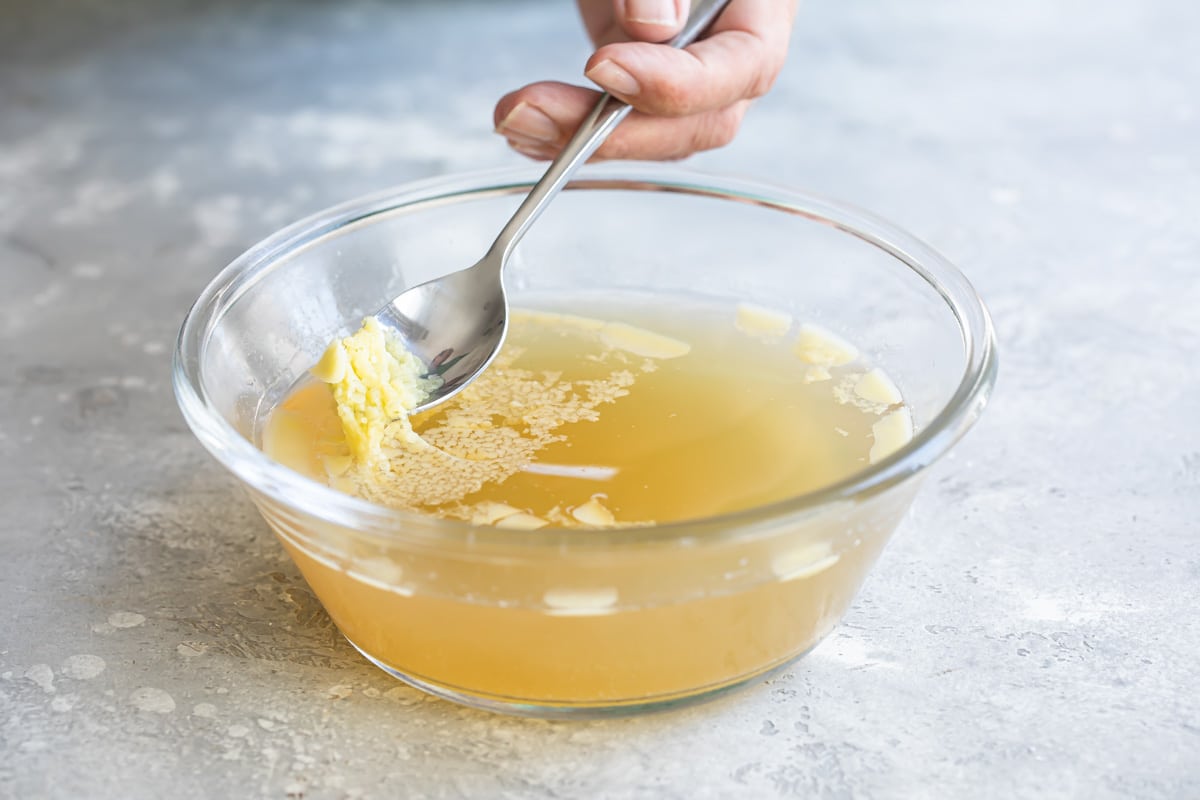
Recipe tips and variations
- Yield: This recipe makes about 8 cups (2 quarts) homemade chicken broth. You’ll also get 4 cups cooked chicken in the process.
- Refrigerate: Store chicken broth in the refrigerator and use within 4 days.
- Freezer: Divide the broth into freezer-safe containers (I like to use 16-ounce glass jars, but freezer bags work too) and leave 1/2-inch head space for expansion. Label and date, then freeze for up to 3 months. Thaw overnight in the refrigerator.
- Leftover roasted chicken carcass: To make chicken broth from a roasted chicken, I recommend adding the leftover roast chicken carcass to a pot with raw chicken. If you boil just a leftover roasted chicken carcass on its own, the broth will be thin and lack body and flavor.
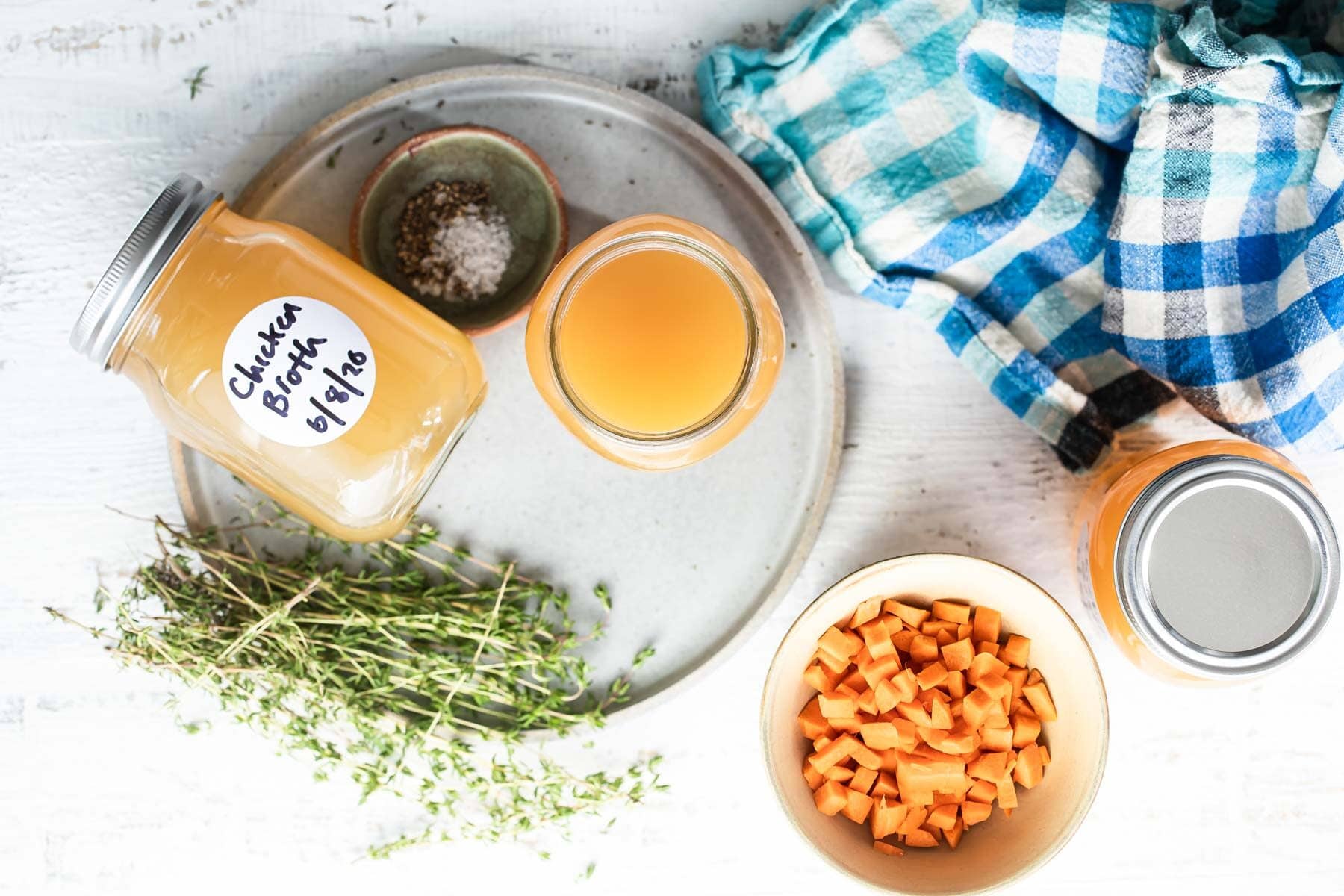
Frequently Asked Questions
Technically, stock is made with just bones, while broth is made with bones and meat.
You can flavor your broth with vegetables, herbs, and spices. If you don’t have much time or patience, add just a clove of garlic, a sliver of onion, and salt.
Yes, absolutely! Plain chicken broth is an absolutely delicious drink. If you want to spruce up your cup of cozy broth, try hot sauce, fresh lemon juice, and some fresh cilantro sprigs.
If your recipe calls for chicken broth, it’s looking for that extra savory flavor. You could substitute bouillon paste or cubes which will give you the same effect. But in some cases, depending on the recipe, you don’t absolutely need chicken broth and could just substitute water. But, you’ll lose flavor that way. It just depends on what you are cooking.
Put your chicken broth to work
Soup and Stew Recipes
Mexican Chicken Soup
Italian Recipes
Italian Wedding Soup
Soup and Stew Recipes
Chicken Ramen
Soup and Stew Recipes
Slow Cooker Ham and Bean Soup
Join Us
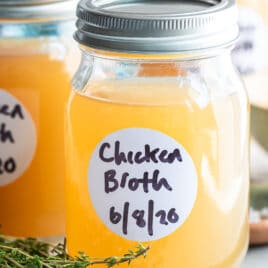
How to Make Chicken Broth
Equipment
- mason jars (I love storing my leftovers in Ball Jars)
Ingredients
- 1 4 to 5 pound whole chicken cut into pieces and giblets removed (see note 1 & 2)
- Cold water about 12 cups (see note 3)
- 1 medium onion peeled and halved
- 1 large carrot peeled and coarsely chopped, or 2 medium carrots (see note 4)
- 1 celery rib coarsely chopped
- 1 tablespoon salt
Sachet (see note 5):
- 6 fresh parsley stems
- 1 sprig fresh thyme
- 2 cloves garlic
- 1 bay leaf
- 1 teaspoon whole black peppercorns
Instructions
- To a Dutch oven or large stock pot, add chicken and cold water to cover (see note 3).
- Over medium-high heat, bring to a boil. Immediately reduce heat to low and skim the foam off the top.
- To the pot add onion, carrot, celery, and salt. If desired, tie parsley stems, thyme, garlic, bay leaf, and peppercorns to make a sachet or add loosely to the pot (see note 5).
- Simmer gently (bubbles should barely break the surface at irregular intervals) until the chicken is cooked through, at least 1 hour or up to 5 hours. The longer the broth simmers, the more flavor it will have. (NOTE: After 1 hour, you should remove the chicken breasts from the pot to prevent them from drying out).
- Remove chicken from pot to a rimmed baking sheet or large bowl. Separate chicken, discarding skin and bones (you should have about 4 cups chicken).
- Strain the broth through a fine-mesh strainer or cheesecloth. Place in a large bowl and chill covered overnight in the refrigerator.
- The next day, scrape off the accumulated fat from the top of the stock and discard. Divide the broth into freezer-safe containers (leaving at least 1/2-inch for expansion), label, and freeze. Or, refrigerate and use within 4 days.
Recipe Video
Notes
- Chicken: This recipe uses a whole raw chicken or the equivalent of cut-up pieces (you can do 4 to 5 pounds of bone-in, skin-on chicken breast, thighs, drumsticks, necks, whatever!).
- Organ meats: The heart and gizzard can be added to the broth if desired, but the liver should be discarded or reserved for another purpose.
- Cold water: Always start with cold water. This helps keep the broth clear, not cloudy. The amount of water used and the length of simmering time will determine the intensity of the broth.
- Vegetables: Some cooks save old vegetable trimmings to add to their broth. I prefer to start with new, fresh vegetables because I think the broth will taste better. So yes, we peel the carrots, and save your vegetable scraps for composting!
- Herbs and spices: A sachet is a fancy term for parsley stems, thyme, bay leaves, peppercorns, and optionally, garlic or cloves, tied up in a piece of cheesecloth with twine. You could also use a tea ball or loose leaf tea bag to hold them. It makes it easier to pull these small ingredients out of the broth later. Or, you can just add everything straight to the pot since you strain the broth at the end.
- Yield: This recipe makes about 8 cups (2 quarts) homemade chicken broth. You’ll also get 4 cups cooked chicken in the process.
- Storage: Store chicken broth in the refrigerator and use within 4 days.
Nutrition
Meggan Hill is a classically-trained chef and professional writer. Her meticulously-tested recipes and detailed tutorials bring confidence and success to home cooks everywhere. Meggan has been featured on NPR, HuffPost, FoxNews, LA Times, and more.

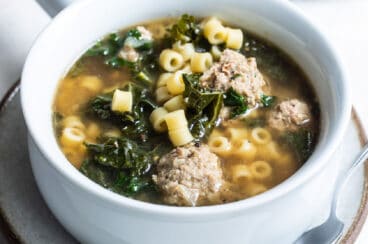

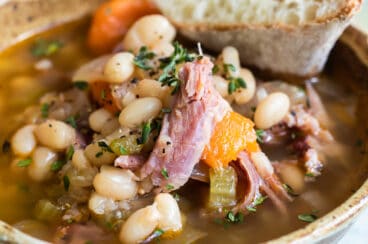
Hi! After the chicken broth is done, do we have to wait four days to use it?
The broth is ready to use immediately! It is safe to use for up to 4 days in the refrigerator. If you want to keep it longer than 4 days, please freeze it and thaw it when you need it. The broth should be consumed within 4 days after making it. – Meggan
Can the cooked chicken be used in other recipes? Also I don’t see where I can pin it to printers.
Hi Noori, I just emailed tech support about the pin-it button for Pinterest. It should be there, but you can’t find it, something must be busted. I’m so sorry about that. To your question, the cooked chicken can and should be used in other recipes. Chicken Salad, we have chicken tinga on the site which is great if you like Mexican food, or any number of various chicken soups, salads, or casseroles. Also any recipe that uses leftover turkey could obviously be made with chicken. I could dump a bunch of links here but I don’t want to do that unless you want them. Well maybe just a couple. I hope this helps! Thanks Noori! -Meggan
https://www.culinaryhill.com/mexican-chicken-soup/
https://www.culinaryhill.com/creamy-chicken-mushroom-and-wild-rice-soup-recipe/
https://www.culinaryhill.com/chicken-pot-pie-recipe/
https://www.culinaryhill.com/chicken-tetrazzini/
https://www.culinaryhill.com/chicken-tinga/ (in this one, you skip the part of boiling the whole chicken and just proceed to make the sauce)
https://www.culinaryhill.com/thai-chicken-salad/
https://www.culinaryhill.com/mango-chicken-bowl/
Home made chicken broth.
Your pictures show storing the broth in Mason jars. To store the broth in canning jars, do you need to pressure can the broth or cold pack the broth?
Or would you pour the broth immediately into the jars after removing the chicken and straining the veggies? Then seal with the lids.
Thanks
Hi Kris! I do show the broth in mason jars but I always always always freeze the broth; I never can it that way. I am not a canning expert, although I keep the Ball Complete Book of Home Preserving on hand for questions like this. My understanding is, broths and stocks are considered low-acid foods so they need to be canned at a higher temperature. You absolutely would need to use a pressure canner, not just a water bath, and get the temperature to 240 degrees. And, you need to use a recipe that has been tested for canning and mine has not. So I don’t recommend you can this recipe, it hasn’t been professionally tested for that and I don’t want you to get sick. So sorry about that and thank you! I will update the post to say that you should not can my recipe. Thanks again. -Meggan
I have plenty of drumsticks but no cleaver for chopping bones… Do drumsticks or chicken legs need to be broken into pieces or is that small enough? I’m also curious if I didn’t add any vegetables or spices if this would be suitable as a bone broth for fasting?
Hi Chris, the legs can be left in tact, it’s not a problem. In regards to fasting, I’m not a nutritionist or a dietician, so I can’t say whether or not this would be appropriate for fasting. Sorry! I would recommend following a recipe that is written by an expert in that area. Sorry again! – Meggan
Wow!! Wow!! Star of the show!
Seems like a waste of a chicken. Couldn’t you roast the chicken, eat it and then just use the carcass???
Hi Pj, thank you for your concern. I cover this in the post:
“To make chicken broth from a roasted chicken, I recommend adding the leftover roast chicken carcass to a pot with raw chicken. If you boil just a leftover roasted chicken carcass on its own, the broth will be thin and lack body and flavor.”
Also, the cooked bird yields about 4 cups of chicken, which can be used for other recipes (also in the post). I hope you try this recipe and love making your own broth! – Meggan
This is really good chicken broth. And I love that I have all that chicken to make chicken salad or chicken soup.
Thank you for writing, Beth! It’s such a great way to use a whole chicken. I’m so happy you enjoyed it! – Meggan
Thanks for this recipe. I stumbled on it while getting ready to prepare chicken and dressing for Thanksgiving. I use my wife’s grandmother’s recipe and have used it for several years now to make the dressing. I worry over doing the dish justice and worry a little over every bit of the process. The recipe calls for chicken in broth. It doesn’t give any other specifics concerning how you arrive at this component, but I am almost certain this was a homemade ingredient. In years past, I have come about the chicken and broth different ways using various mixtures of my own “broth” and chicken to using canned sources for both the chicken and the broth. Sometimes this was out of necessity of the circumstances (like being asked to make it last minute with no time or place to shop) or just being ill prepared. This year, I used the recipe here to prepare my chicken and broth, and I wound up with the best overall results for the dressing that I may have ever managed. It’s always been pretty good, but the flavor this time was richer without anything being overpowering. I also have a few jars of broth left over for other purposes including a quick chicken noodle soup on the day I made it.
You’re so welcome, Derek! I completely understand the want and the pressure to do a family-favorite recipe justice. I’m so happy that the dressing turned out well! Thank you for taking the time to write and share. I hope you have a great weekend, and wonderful future Thanksgiving meals! – Meggan
To Derek. Would it be possible to post your dressing recipe here? Your dressing sounds scrumptious! Thanks, if you can. Carol
I’ve always shied away from making chicken broth – seemed too complex and time consuming Tried your method today and it was easy and the time it took was worth it. thanksgiving dinner will be a lil extra special and we have plenty of shredded chicken to tie us over for a day or two.
Thanks so much.
You’re so welcome, Millie! Thank you for trusting my recipe! I’m so happy you found it easy to make. I hope you have a happy Thanksgiving! Take care! – Meggan
This is excellent…thank you!!!
You’re welcome, Sylvia! Take care! – Meggan
Love the recipe, thanks!
To those asking about freezing. A better technique is to use freeze ziploc bags. Using the gallon (or smaller, your choice) you can fill them such that you can lay them flat, without any air, and stack them on top of each other.
As for shelf life you can keep frozen stock in the freeze for much longer than 3 months.
If this is chicken broth, then what is chicken soup? I needed chicken broth to make spanish rice, so I found this recipe, and lemme tell you…. the finished product is better than any canned chicken soup you will ever find in the market. It’s a waste to use it as broth imo. All you need to do is add some noodles, and you’ll have the best chicken noodle soup you ever tasted. Definitely will be my go-to soup recipe for the winter.
I see several people freeze items in canning jars. I have tried this twice. My jars cracked in the freezer. I’m leaving plenty of headspace and the contents are cool. I’m 58 and can often, so I’m a little baffled.
Hi Karen, thank you for your question. I’m so sorry you’ve had jars crack in the freezer. I would make sure the jars you are using are suitable for both canning and freezing. Some brands recommend not freezing their jars that have “shoulders” and instead recommend using their tapered ones which allow expansion easier. Also some may recommend leaving quite a bit of headspace (1 to 2 inches). Also, be sure the jars have space between them in the freezer to prevent them from bumping into each other, which could also lead to the jar breaking. I hope this information helps! Please let me know if you have any other questions! Take care – Meggan
silly Question, what do you do with the chicken meat when done? Surely you do not throw it away??
Hi Susie! Thank you for your question. I like to separate the chicken meat from the skin and bones, shred it, and use it in other recipes. Take care! – Meggan
Hi Meggan,
I just used your recipe to make the broth and it turned out so tasty. I’m hoping you can explain something to me: when I took my broth out of the fridge, it has completely jelled, like chicken flavored gelatin. I’ve had this happen before with other recipes and it does turn back into a liquid when it’s heated up. I used 4 legs, 4 wings and 2 backs totaling 4 lbs. I cooked this for probably 3.5-4 hrs. Could it be the fact that my chicken parts had a lot of bones? Just thought maybe you could shed some light on this. Thanks for sharing your recipe. Can’t wait to make your chicken noodle soup 🙂
Cheri’
Hi Cheri’! Thank you so much for your question, and yes! Collagen is released from skin and bones when the chicken is simmering and becomes gel-like once it cools. It’s a sign that your broth is well-made! I hope you love the chicken noodle soup! – Meggan
I have a silly question since I am making chicken soup for the first time: you say to simmer for 1-5 hours. But take chicken breasts out after 1 hour. Earlier on you said to use a whole chicken (breast, thighs etc.). I assume you mean to take all chicken out after 1 hour, not just breasts. Correct? Also, 1-5 hours is a big difference. What is the ideal summer time overall? Thank you!!
Hi Denise! Thank you so much for the question. I’m sorry for the confusion! The whole chicken, cut into parts or its equivalent (say 4 to 5 pounds of thighs) is what is used here and the parts with bones can simmer longer than the breasts. That’s why you should pull out the breasts after an hour so the chicken isn’t dry. You can pull everything out after the hour, but the longer you can let the rest simmer, the more flavorful your broth will be. I hope this clarifies it for you!
Also, if you haven’t found a recipe to make the chicken soup with, I hope you try my Chicken Noodle Soup! – https://www.culinaryhill.com/chicken-noodle-soup-recipe/. Thank you again and please write back if you have any more questions, I would love to help! – Meggan
This was the best chicken broth I’ve ever made. Turned out great. I did add 4 cups of water at the end and simmered about 15 more min. It didnt jeopardize the flavor at all. I also only had dry Thyme and it worked great. I was reading comments. If anyone is asking about chicken I used 1/2 of a small chicken and 2 breasts. That’s what I had on hand. Seriously love this recipe. Passing it on to my kids.
Hi Kim, so happy it turned out well! Take care! – Meggan
Can this broth be canned?
Hi Lenora, this recipe hasn’t been tested for canning. I unfortunately am not a home preserving/canning expert, and for safety reasons, I think you should follow recipes that have been developed and tested for canning. Sorry about that – Meggan
Can you then use the bones to make bone broth?
Hi Jules, I believe you can, but I haven’t tried it myself. If you do, I would recommend following a recipe that has been written and tested with chicken bones that were already used to make broth. Hope this helps! – Meggan
I have a bad habit of rarely following recipes; however, I need to up my game in the broth making department so I’m going to make this one as written. Just have a couple things I want to clarify:
1. The pot stays uncovered throughout the whole process? No lid?
2. Is the 1 tbsp of salt regular or kosher salt?
Hi Katie! Happy to help! The pot remains uncovered while simmering. I prefer kosher salt, but regular table salt will also work. I would say just use what you have on hand. Take care! – Meggan
This was delicious! I will use this recipe from now on. Now I need a receipt for chicken croquettes for some of the leftover chicken please give me one
Hi Pam, I’m so glad you loved this broth! I love your idea! Adding it to my list! Thank you and take care! – Meggan
I haven’t tried the recipe yet but felt compelled to mention the confusion over the final yield. 8 cups of stock is 2 quarts so yes Meggan, you are correct with that. But what you are not seeing is that your “Yield” section under your final notes states you get 4 cups (2 quarts) chicken stock. 4 cups is only 1 quart. Something needs to be corrected.
Hi Debbie, thank you for noticing that small error on note 6 in the recipe card. I’ve corrected it, and I hope you love this recipe! Take care and thank you again for taking the time to let me know about this so I can correct it. The final yield is about 8 cups of broth and 4 cups of cooked chicken. Hope this clears it up! – Meggan
4 cups is one quart, not two quarts.
Hi Barb, this recipe makes 4 cups cooked chicken and 2 quarts (8 cups) of the best chicken broth. – Meggan
I’m going to try it today. Hope for the best.
Can I essentially just make chicken noodle soup using this recipe? As in pull the chicken out once it’s cooked, shred it up and throw it back in the broth, leaving the vegetables and adding some noodles?
Hi Log, I don’t see why not! Hope you enjoy. – Meggan
4 cups is two pints or one quart.
Can you start with a whole frozen chicken?
Hi Joan, yes! If you can, I would suggest using a big enough pot so the entire chicken can be submerged. It will also take longer so be sure to check your chicken temps and make sure the thickest parts hit 165 degrees. Hope you enjoy! – Meggan
Is one celery ribs, just one piece off the bunch or the entire bunch?
Hi Diana, one celery rib is one piece off the whole bunch. Thank you! 🙂 -Meggan
Heya i am for the first time here. I followed your instructions and it was perfect.
This seems super easy! I’m going to try it today.